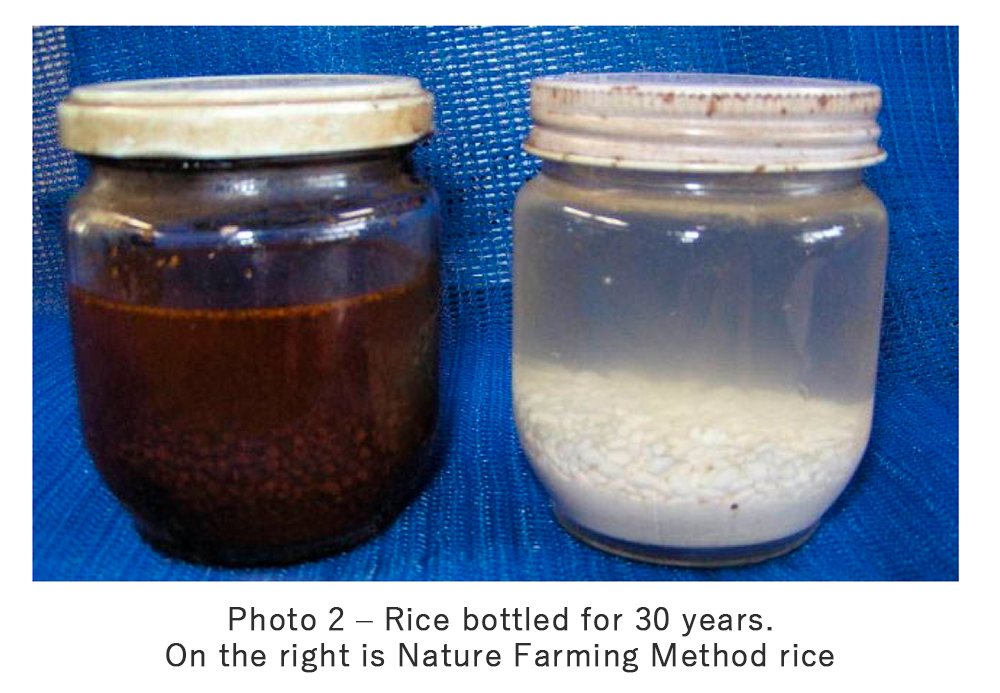Kiyoshi Suzuki, MD, PhD
President, MOA Health Science Foundation
Summarizing my third essay entitled, “Soil of Organic Farming and Nature Farming Method are Full of Vitality,” both the Organic Farming and Nature Farming Method are farming methods that utilize the inherent power of the soil and it is very important to obtain an environment (biodiversity) where various microorganisms can exist. To that end, organic farming uses good quality compost, and the MOA Nature Farming Method focuses on adjusting the physical properties of the soil. In my fourth essay, I want to share about how the various soils affect the crops.
1. Characteristics of the Nature Farming Method Crops

If you ask experts, they can tell by looking at the roots of the crop if it is grown using the Nature Farming Method. I once saw the roots of a cabbage grown in a glass tank at Ohito Farm in Izunokuni City, Shizuoka Prefecture. The roots of the cabbage grew deeply to a depth of 1 m or more, but cabbage grown using the conventional farming method does not grow roots half the size. I was surprised at how different it was.
In Nature Farming, it is important to have the air permeability of the soil and the circulation of water in which water penetrates to the tips of deep roots and the excess water evaporates, which is why the softness of the soil is important. So, why do the Nature Farming Method crops grow deeper? In fact, it seems that nitrogen, which is indispensable for the growth of crops, is abundant in the deep parts of Nature Farming fields. Even if you do not mix nitrogen fertilizer, if one can grow the roots deep in the soil and breathe with water, one can harvest good crops. Conventional farming, on the other hand, provides sufficient fertilizer and does not require rooting. The ultimate of that is like the hydroponics method using liquid fertilizer and crops can be produced without using soil.
I heard that rice grown by the Nature Farming Method has roots deep in the ground, so it is hard for it to fall down even in the event of a typhoon or other storm and flood damage. In addition, it was reported in the newspaper that the rice grown using the conventional farming method were severely damaged by the record-breaking cold in 1993, but the harvesting of the Nature Farming Method rice were relatively successful. (Photo 1). Even in the drought in Hokkaido in 2021, the Nature Farming Method crops extended their roots deep into the soil and absorbed the water, so the yield did not drop so much.
In the conventional farming method, the nutrients in the soil are biased and the growth is not good when continuous cropping is performed, so the next year the crops are planted in a different place from the previous year. On the other hand, in well-maintained Nature Farming Method fields, soil microorganisms create an environment suitable for the crop, so continuous cropping is said to yield more. I saw a carrot field at Ohito Farm, but the field that was continuously cultivated had better growth. I realized that I should not look at the Nature Farming Method with the common sense of conventional farming. If one continues the Nature Farming Method for many years, the number of natural enemies that eat pests will increase, and in the end, the number of pests will decrease.
2. Nature Farming Method crops are hard to spoil

I am not sure how many people are aware of how hard it is to spoil Nature Farming Method crops. Photo 2 shows rice bottled 30 years ago. Conventional farming rice turns brown and rots, but natural Nature Farming Method rice is white and clearly visible.
At my home, I have studied how to rot the crops using the Nature Farming Method and conventional farming in a free study during my children’s summer vacation. Traditional farmed vegetables rot to muddy, but many Nature Farmed vegetables have dried up. Nature Farmed rice soaked in water had a nice scent like amazake (sweet rice wine) the next day, but conventional farmed rice smelled bad and moldy from the next day. This is an easy experiment, so if anyone is interested, please try it.

There are few data that show the difference between the Nature Farming Method, Organic Farming, and conventional farming. Photo 3 is an example of carrots grown in an experimental field in Kagoshima City.
As you can see, the Nature Farmed carrots are thin and small, and the yield was low that year, however, the aroma and taste were better than other farming methods. There is still a trick to be learned in order to secure the yield by the Nature Farming Method. By that, I suggest that we all have much gratitude for the Nature Farming Method crops that we will receive after various hardships.
In the next essay, I will share about the effects of crop components of the Organic Farming and Nature Farming Method on animals.
【Profile】
Kiyoshi Suzuki graduated from the Chiba University School of Medicine in 1981. He is a doctor of medicine. After working as a Deputy Director of Pediatrics at Sakakibara Memorial Hospital, he worked at the Naruki Clinic, and later became the director of Gyokusenkai MOA Takanawa Clinic / Tokyo Clinic, Director of MOA Health Science Foundation and Honorary Director of the Tokyo Clinic. He is also the Director of the Japan Society for Integrated Medical Sciences and Chairman of the International Committee. In 1994, he was awarded the Young Investigator’s Award by the Japanese Circulation Society.






